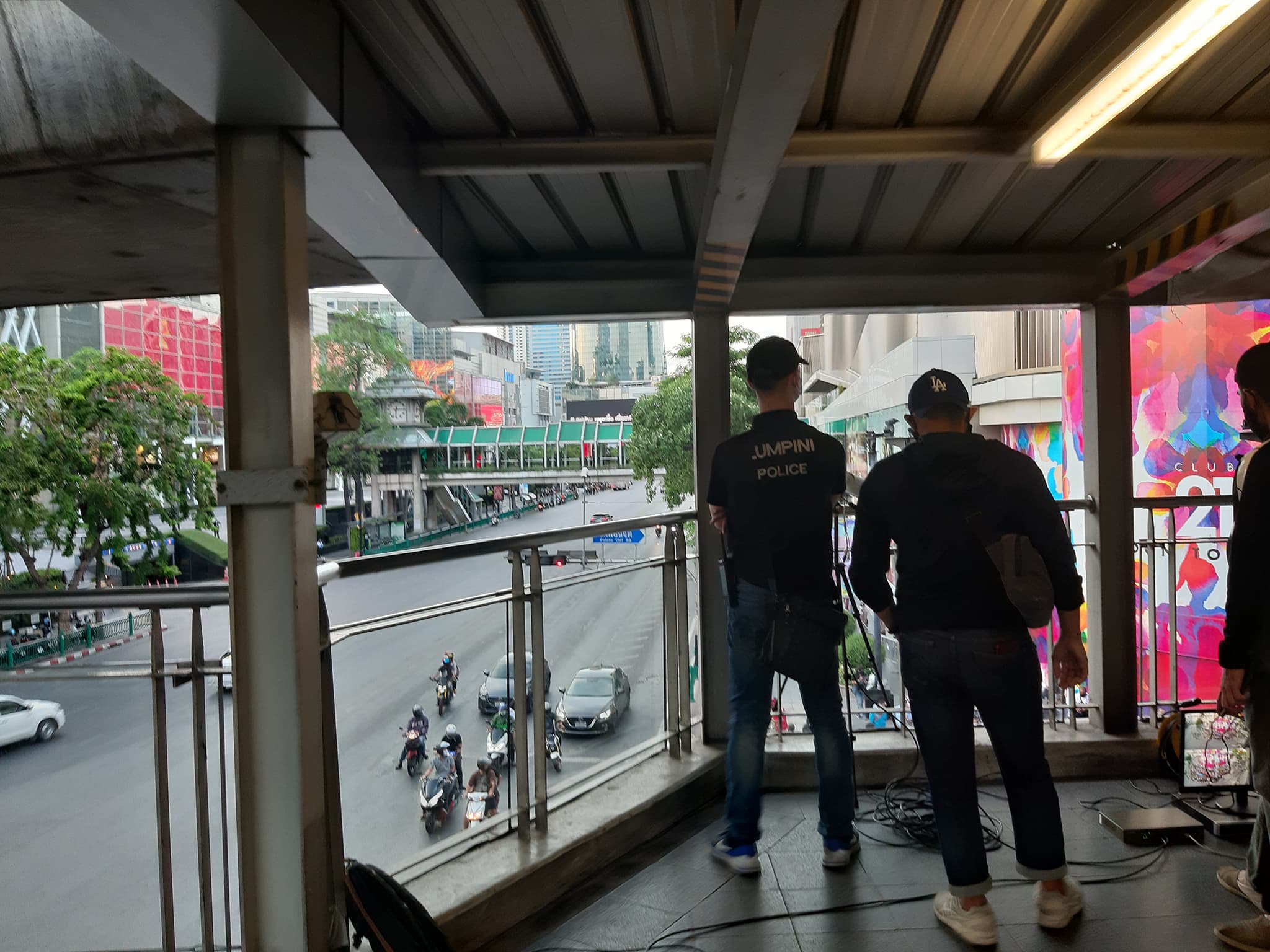Red shirts and their relatives have commemorated the 10th anniversary of the military crackdown which left 98 dead and thousands injured. No officers have ever been brought to justice for the killings even though many inquests found that the military were responsible.

The red shirts raised 3-fingers salute, an anti-government gesture.
On 19 May, the 10th anniversary of the 2010 military crackdown against the United Front for Democracy Against Dictatorship (UDD), or red shirts, was commemorated.
Around 30-40 people, mostly red shirts, gathered at Ratchaprasong intersection, a protest site that in 2010 was surrounded and attacked by the military. They came to remember and to underscore the fact that the officials involved in the killing have still not been brought to justice.

Police officers monitoring the red shirt commemoration on the skywalk.
At the scene, around 30-40 police officers were also present, as well as nurses providing temperature screening and hand sanitiser. The attendees sang a song, lit candles, raised 3-finger salutes - the anti-dictatorship gesture - and left the venue at around 7pm.
Another commemoration was held simultaneously in front of Wat Pathum Wanaram temple, where 6 people were killed on 19 May 2010, including volunteer nurse Kamonked Akhad, whose mother, Phayao, attended the event.


Phayao Akhad attended her daughter commemoration, Kamonked (in a portrait)
The ceremony was held in front of the temple gate as the temple announced its closure on 18-20 May for disinfection due to the outbreak of Covid-19. These dates coincide with the dates of the crackdown commemorations.
Phayao said that there always is difficulty with the temple when she wants to hold a commemoration. The 10-year attempt to bring her daughter’s killer to justice is still far from its goal.
“It cannot change history. People died here. My daughter died in this temple, in the sanctuary. After we have fought for 10 years, is this a sanctuary or killing field?” asked Phayao.
During the crackdown, Wat Pathum Wanaram was proposed by peace intermediaries as a sanctuary, a space free from hostile action by either side. Violence reached the protesters and volunteers who took shelter in the temple nevertheless.
An inquest found that Kamonked was killed by a .223 bullet from the 3rd Special Assault Team that was stationed on the BTS railway tracks overlooking the temple. The post-mortem forensics did not find any evidence that the 6 dead had fired any weapons.
Phayao filed a murder complaint against the soldiers who were stationed on the BTS railway tracks. However, a military court threw out the charges against 8 accused soldiers. The prosecution said that there was no evidence of them committing murder. She then filed another complaint with the Department of Special Investigation (DSI) but this also yielded no progress.
The crackdown on the red shirts resulted in at least 98 deaths and more than 2,000 injured. The DSI issued a finding in September 2012 indicating that the military was culpable in 36 deaths.
Until now, no officers who were responsible for the crackdown have been held to account for the killing. The Asian Forum for Human Rights and Development (FORUM-ASIA) and the Asia Democracy Network (ADN) have called on the Thai government to re-activate its investigation into the crackdown, and ensure transparent proceedings and due process for all involved.
“Ten years on, none of the operating soldiers, commanding officers or government officials who authorised the lethal military operations have been convicted of criminal charges. The massacre and the impunity with which it was allowed to happen, continues to mar the country’s image and creates a legacy of fear.
“Those criminally responsible need to be held accountable, regardless of position or political affiliation. Without this accountability, the right to fundamental freedoms, and the ability of the public to trust its Government remains compromised,” reads the statement.
The commemorations saw fewer attendees than usual due to the Covid-19 outbreak and red shirt leaders attended separate events.
In Chiang Mai, the local UDD held a Buddhist merit-making ceremony to pay tribute to the dead protesters. 30 people, including several local red shirt leaders, attended the event.
The red shirt’s basic demand was the dissolution of the unelected Abhisit-led government, which had ruled the country since 2008 after a Constitutional Court decision had dissolved the Phalang Prachachon Party (PPP) led by Prime Minister Somchai Wongsawat.
The PPP was mainly composed of former members of the Thai Rak Thai Party that was itself dissolved after the 2006 coup d’état which ousted its leader, Thaksin Shinawatra. PPP voters’ dissatisfaction was stoked by many media reports that the military had played a large role in influencing some Thai Rak Thai MPs to join the opposition to take over parliament. This dissatisfaction led to mass protests in 2009, which were suppressed by the military.

